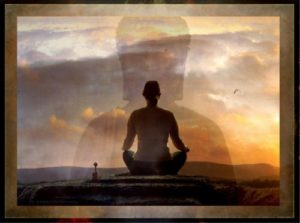The Variety of Transcendent States During Meditation
By John M. de Castro, Ph.D.
“Ancient masters described intense transcendent states that result from meditation. A true awakening, transformation of consciousness, oneness with the ALL. Many esoterics have glimpsed these levels of consciousness, and for a few it became a persistent state – enlightenment.” – Future Thinkers
Millions of people worldwide seek out transcendent experiences by engaging in practices, such as meditation, yoga, and prayer. Others use drugs such as peyote, mescaline, LSD, ayahuasca and psilocybin to induce these experiences. Transcendent experiences have many characteristics which are unique to the experiencer, their religious context, and their present situation. But, the common, central feature of transcendence is a sense of oneness, that all things are contained in a single thing, a sense of union with the universe and/or God and everything in existence. This includes a loss of the personal self. What they used to refer to as the self is experienced as just a part of an integrated whole. People who have had these experiences report feeling interconnected with everything else in a sense of oneness with all things. Although transcendent experiences can vary widely, they all contain this experience of oneness.
I published a summary and review of these characteristics in a paper entitles “A Model of Enlightened/Mystical/Awakened Experience. It can be found on Research Gate at https://www.researchgate.net/publication/281807307_A_Model_of_EnlightenedMysticalAwakened_Experience.
Because of their relatively rare, ineffable, and completely subjective characteristics, transcendent experiences have received only a small amount of scientific attention. This, however, flies in the face of their importance to humans of spirituality. They are central to the human search for the nature and meaning of existence. Hence, there is a need for greater scientific attention to transcendent experiences.
In today’s Research News article “A Systematic Review of Transcendent States Across Meditation and Contemplative Traditions.” Wahbeh and colleagues summarize the published peer-reviewed scientific literature on transcendent experiences occurring during meditation. They identified 25 studies involving a total of 672 participants that measured a variety of physiological, psychological, and experiential variables during or after the experience of transcendence during meditation.
They found that “as meditation progresses, a person’s sense of agency, location and boundaries in time and space become weaker and the sense of self dissolves”. This was associated with relaxed wakefulness which included decreased respiration, skin conductivity, and muscle relaxation, increase in the brain’s alpha rhythm power, alpha blocking, and changes in brain area interconnectedness and activity. The meditators report experiencing “a sense of timelessness, spacelessness, unconditional love, peace, profound joy, and loss of boundaries of the self. In Christian contemplative traditions, there is a “transformative presence of God” and religious ecstasy.” The meditators report changes in perception that are reflected in changes in brain activity in the sensory cortices. Phenomenologically these changes are reported to not alter the present sensory environment but transcends it producing a sense on oneness of all things.
The studies reported were very heterogenous with different methodologies, measurements, and focus and with great differences in scientific quality and bias. This is unfortunate, as this is such an important area of study. There is a need for more work under similar conditions with standardized measurements and tighter experimental controls. Rather than considering the published research as definitive, it should be viewed as a first step in the investigation of transcendent experiences during meditation. But, the published studies to date produce a tantalizing glimpse into these states, reflecting an altered interpretation of reality and perhaps insight into the nature of being.
“during transcendent states, we slip into an altered state of consciousness different from our ordinary waking or rational consciousness. “No account of the universe in its totality can be final which leaves these other forms of consciousness quite disregarded.” – William James
CMCS – Center for Mindfulness and Contemplative Studies
This and other Contemplative Studies posts are also available on Google+ https://plus.google.com/106784388191201299496/posts and on Twitter @MindfulResearch
Study Summary
Wahbeh H, Sagher A, Back W, Pundhir P, Travis F. A Systematic Review of Transcendent States Across Meditation and Contemplative Traditions. Explore (NY). 2018 Jan – Feb;14(1):19-35. doi: 10.1016/j.explore.2017.07.007. Epub 2017 Oct 23.
Background
Across cultures and throughout history, transcendent states achieved through meditative practices have been reported. The practices to attain transcendent states vary from transcendental meditation to yoga to contemplative prayer, to other various forms of sitting meditation. While these transcendent states are ascribed many different terms, those who experience them describe a similar unitive, ineffable state of consciousness. Despite the common description, few studies have systematically examined transcendent states during meditation.
Objectives
The objectives of this systematic review were to: 1) characterize studies evaluating transcendent states associated with meditation in any tradition; 2) qualitatively describe physiological and phenomenological outcomes collected during transcendent states and; 3) evaluate the quality of these studies using the Quality Assessment Tool.
Methods
Medline, PsycINFO, CINAHL, AltHealthWatch, AMED, and the Institute of Noetic Science Meditation Library were searched for relevant papers in any language. Included studies required adult participants and the collection of outcomes before, during, or after a reported transcendent state associated with meditation.
Results
Twenty-five studies with a total of 672 combined participants were included in the final review. Participants were mostly male (61%; average age 39 ± 11 years) with 12.7 ± 6.6 (median 12.6; range 2–40) average years of meditation practice. A variety of meditation traditions were represented: (Buddhist; Christian; Mixed (practitioners from multiple traditions); Vedic: Transcendental Meditation and Yoga). The mean quality score was 67 ± 13 (100 highest score possible). Subjective phenomenology and the objective outcomes of electroencephalography (EEG), electrocardiography, electromyography, electrooculogram, event-related potentials, functional magnetic resonance imaging, magnetoencephalography, respiration, and skin conductance and response were measured. Transcendent states were most consistently associated with slowed breathing, respiratory suspension, reduced muscle activity and EEG alpha blocking with external stimuli, and increased EEG alpha power, EEG coherence, and functional neural connectivity. The transcendent state is described as being in a state of relaxed wakefulness in a phenomenologically different space-time. Heterogeneity between studies precluded any formal meta-analysis and thus, conclusions about outcomes are qualitative and preliminary.
Conclusions
Future research is warranted into transcendent states during meditation using more refined phenomenological tools and consistent methods and outcome evaluation.
https://www-sciencedirect-com.ezproxy.shsu.edu/science/article/pii/S1550830717300460

